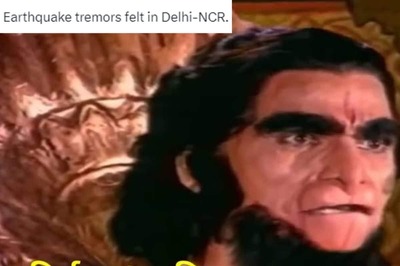
views
Thursday witnessed earthquake tremors in Delhi and nearby areas, extending to Rajasthan, Jammu and Kashmir, and the South of the Pir Panjal region. Lahore in Pakistan also reported feeling the quake. The National Center for Seismology identified the epicentre near Afghanistan for the magnitude 6.1 earthquake, felt at 2:50 p.m.
Meanwhile, social media, particularly on the micro-blogging site ‘X,’ ‘exploded’ with users confirming their experience of the tremors or sharing memes about Delhi’s frequent seismic activity, treating it as a usual occurrence for the residents.
Take a Look:
Delhi walo ke liye ye koi nayi bat nahi hai— Shivaye (@shivaye01) January 11, 2024
Delhiites took to Twitter to check who else Felt the #Earthquake pic.twitter.com/fKUoJ1rbmv— زماں (@Delhiite_) January 11, 2024
People from Delhi coming on Twitter to confirm earthquake#Earthquake pic.twitter.com/3aa8biHt8d— RUDRA☀️❤️ (@invincibl39) January 11, 2024
A strong Earthquake tremors felt in Delhi-NCR after every week*Le Delhites:- #Earthquake pic.twitter.com/WIcGiGqiaz— Radhika Chaudhary (@Radhika8057) January 11, 2024
Tectonic plate rightnowpic.twitter.com/rb6uLjp51W— Pritesh Shah (@priteshshah_) January 11, 2024
Mandatory NCR earthquake meme .. pic.twitter.com/5v3OFnSD21— Mukesh (@mikejava85) January 11, 2024
Hum Delhi walo ko Earthquake ki aadat hogayi hainKab aaya Kab gaya pta nahi chala
— INDIAN (@indian18071993) January 11, 2024
Amid the unfolding events, the question arises: Why is Delhi-NCR prone to tremors? The answer lies in the seismic activity of the region. India, being in a seismically active zone, faces a significant threat, with over 59 percent of its land under moderate to severe seismic hazard, according to the National Disaster Management Authority.
Also Read: Disneyland Actors Showed Heroic Spirit When Earthquake Struck Japan
Delving deeper, Zone V of the seismic zoning map is the most active and high-risk, encompassing eight states and union territories. Delhi-NCR, situated in Zone IV, falls under the category of ‘high risk.’ Parts of Delhi and northern Uttar Pradesh lie in Zone IV, while Gurugram is positioned on seven fault lines, capable of causing a magnitude 7.5 quake if activated.
Therefore, earthquakes ranging from 4 to 4.5 magnitudes are common in this region. Delhi’s geographical location, nestled at the foothills of the Himalayas, contributes to its vulnerability to earthquakes. Despite experiencing 25 to 30 such earthquakes in the last century with minimal damage, Delhi faces a unique position, affected not only by Himalayan quakes but also by fault lines in closer proximity.


















Comments
0 comment